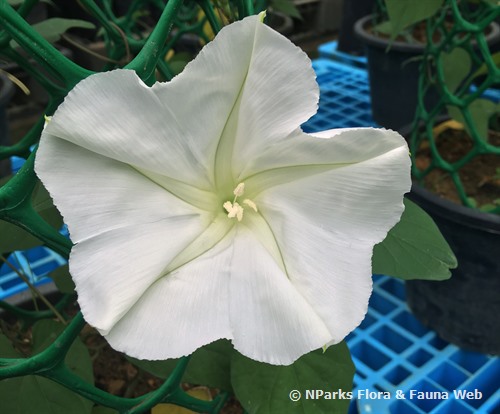
Back
Ipomoea quamoclit L. 'White Feather'
| Family Name: | Convolvulaceae |
| Synonyms: | Quamoclit vulgaris 'White Feather', Quamoclit pennata 'White Feather' |
| Common Name: | White Cypress Vine, White Star Glory, White Star of Bethlehem, White Hummingbird Vine, 白茑萝 |
Name
Classifications and Characteristics
| Plant Division | Angiosperms (Flowering Seed Plants) (Dicotyledon) |
|---|---|
| Plant Growth Form | Climber, Creeper |
| Lifespan (in Singapore) | Perennial |
| Mode of Nutrition | Autotrophic |
| Plant Shape | Irregular |
| Maximum Height | 5 m to 6 m |
Biogeography
| Preferred Climate Zone | Tropical, Sub-Tropical / Monsoonal |
|---|
Description and Ethnobotany
| Growth Form | Slender herbaceous vine, climbing by twining its flexible stems around physical supports, reaching up to 6m in height. In the absence of a vertical support, plant creeps indefinitely, rooting at nodes. |
|---|---|
| Foliage | Entire leaves 7cm long by 4cm wide, broadly elliptical to ovate in outline, but deeply incised where each linear lobe is only 1mm across, thus imparting a delicate lacy appearance to the foliage. |
| Flowers | White, trumpet-shaped, with joined petals (corolla), as well as exserted stamens and stigma. Produced in small cymes of 1-3 flowers, which remain open during the day, and close by late afternoon or evening. Relatively free-blooming, visited by nectar-seeking ants, hummingbirds and butterflies. |
| Fruit | Ovoid dehiscent papery capsules, 5-8mm long, ripening from green to brown. Seeds small and black, usually 4 per fruit. |
| Similar | Much less common than the species form Ipomoea quamoclit (Cypress Vine), which bears scarlet red flowers, but otherwise shares a similar morphology and growth behaviour. |
| Cultivation | Fast-growing. Provide well-drained soils. Fairly drought-tolerant when established. May be difficult to remove from bushes, so constrain the plant to a trellis if desired. Used as a perennial in the tropics, also cultivated as an annual in temperate regions. Easily propagated by seeds or stem cuttings. |
| Etymology | Genus epithet 'Ipomoea' derived from Greek terms 'ips' and 'homoios' meaning 'resembling a worm', alluding to the twining habit of plants from this genus. Species epithet 'quamoclit' derived from Greek name 'kuamos' for dwarf kidney bean, a reference to the seedlings' distinctively-shaped cotyledons (seed leaves). |
Landscaping Features
| Desirable Plant Features | Ornamental Foliage, Ornamental Flowers |
|---|---|
| Landscape Uses | Vertical Greenery / Green Wall, Flowerbed / Border |
| Thematic Landscaping | Moonlight Garden, Butterfly Garden, Naturalistic Garden, Wildflower Garden |
Fauna, Pollination and Dispersal
| Fauna Pollination Dispersal Associated Fauna | Butterfly-Attracting, Bird-Attracting |
|---|---|
| Pollination Method(s) | Biotic (Fauna) (Insects (Butterfly, Moth), Insects (Ant, Beetle, Fly, Thrip, Wasp), Vertebrates (Bird)) |
| Seed or Spore Dispersal | Abiotic (Explosive Dehiscence) |
Plant Care and Propagation
| Light Preference | Full Sun |
|---|---|
| Water Preference | Moderate Water |
| Plant Growth Rate | Fast |
| Rootzone Tolerance | Easy to Grow, Drought Tolerant, Fertile Loamy Soils, Well-Drained Soils |
| Maintenance Requirements | Moderate |
| Propagation Method | Seed, Stem Cutting |
Foliar
| Foliage Retention | Evergreen |
|---|---|
| Mature Foliage Colour(s) | Green |
| Mature Foliage Texture(s) | Smooth, Thick |
| Foliar Type | Simple / Unifoliate |
| Foliar Arrangement Along Stem | Alternate |
| Foliar Shape(s) | Non-Palm Foliage (Elliptical) |
| Foliar Venation | Pinnate / Net |
| Foliar Margin | Palmately Lobed |
Non - Foliar and Storage
| Stem Type & Modification | Herbaceous |
|---|---|
| Root Type | Underground (Fibrous Root) |
Floral (Angiosperm)
| Flower & Plant Sexuality | Bisexual Flowers |
| Flower Colour(s) | White |
|---|---|
| Flower Symmetry | Radial |
| Individual Flower Shape | Trumpet-shaped |
| Inflorescence Type | Cyme |
| Flowering Period | Free-Flowering |
| Flower Lifespan on Plant | 1 Day |
| Flowering Habit | Polycarpic |
Fruit, Seed and Spore
| Mature Fruit Colour(s) | Brown |
|---|---|
| Fruit Classification | Simple Fruit |
| Fruit Type | Dehiscent Dry Fruit , Capsule |
Image Repository
Others
| Master ID | 29690 |
|---|---|
| Species ID | 3999 |
| Flora Disclaimer | The information in this website has been compiled from reliable sources, such as reference works on medicinal plants. It is not a substitute for medical advice or treatment and NParks does not purport to provide any medical advice. Readers should always consult his/her physician before using or consuming a plant for medicinal purposes. |

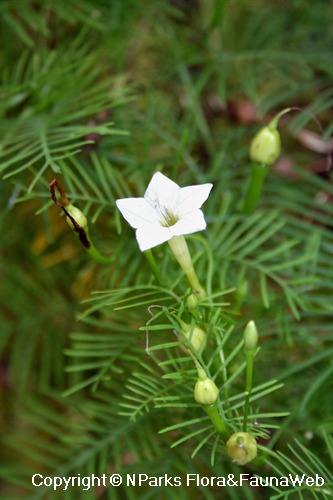
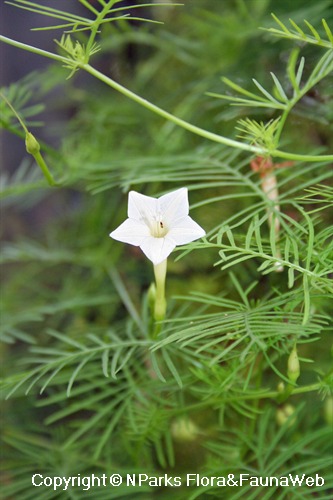
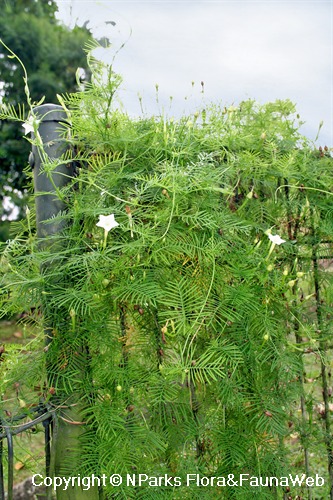

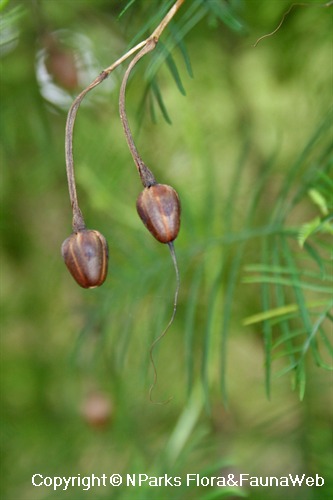
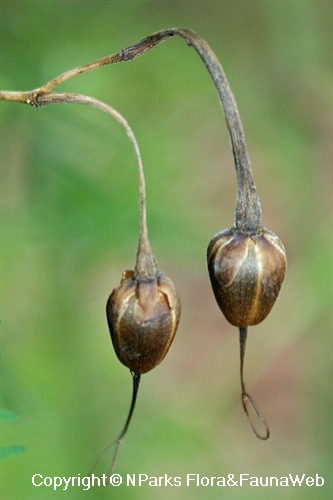
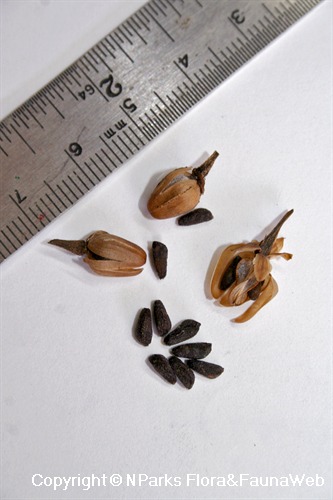
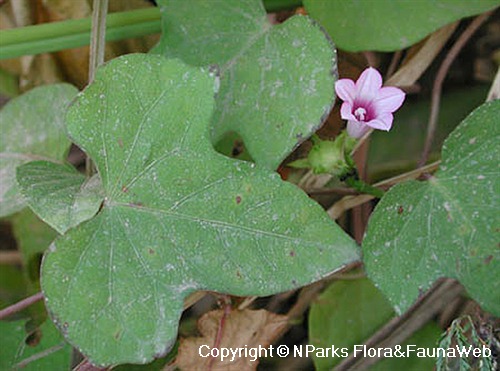
_lowres.jpg)

